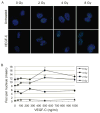Vascular endothelial growth factor-C enhances radiosensitivity of lymphatic endothelial cells
- PMID: 24201897
- PMCID: PMC3981926
- DOI: 10.1007/s10456-013-9400-7
Vascular endothelial growth factor-C enhances radiosensitivity of lymphatic endothelial cells
Abstract
Radiation therapy after lymph node dissection increases the risk of developing painful and incurable lymphedema in breast cancer patients. Lymphedema occurs when lymphatic vessels become unable to maintain proper fluid balance. The sensitivity of lymphatic endothelial cells (LECs) to ionizing radiation has not been reported to date. Here, the radiosensitivity of LECs in vitro has been determined using clonogenic survival assays. The ability of various growth factors to alter LEC radiosensitivity was also examined. Vascular endothelial growth factor (VEGF)-C enhanced radiosensitivity when LECs were treated prior to radiation. VEGF-C-treated LECs exhibited higher levels of entry into the cell cycle at the time of radiation, with a greater number of cells in the S and G2/M phases. These LECs showed higher levels of γH2A.X-an indicator of DNA damage-after radiation. VEGF-C did not increase cell death as a result of radiation. Instead, it increased the relative number of quiescent LECs. These data suggest that abundant VEGF-C or lymphangiogenesis may predispose patients to radiation-induced lymphedema by impairing lymphatic vessel repair through induction of LEC quiescence.
Conflict of interest statement
Conflict of Interest Notification: There are no conflicts of interest related to the work presented in this manuscript.
Figures





Similar articles
-
Sunitinib inhibits lymphatic endothelial cell functions and lymph node metastasis in a breast cancer model through inhibition of vascular endothelial growth factor receptor 3.Breast Cancer Res. 2011 Jun 21;13(3):R66. doi: 10.1186/bcr2903. Breast Cancer Res. 2011. PMID: 21693010 Free PMC article.
-
Vascular Endothelial Growth Factor C (VEGF-C) Sensitizes Lymphatic Endothelial Cells to Oxidative-Stress-Induced Apoptosis through DNA Damage and Mitochondrial Dysfunction: Implications for Lymphedema.Int J Mol Sci. 2024 Jul 17;25(14):7828. doi: 10.3390/ijms25147828. Int J Mol Sci. 2024. PMID: 39063073 Free PMC article.
-
Vascular endothelial growth factor-C secreted by pancreatic cancer cell line promotes lymphatic endothelial cell migration in an in vitro model of tumor lymphangiogenesis.Pancreas. 2007 May;34(4):444-51. doi: 10.1097/mpa.0b13e31803dd307. Pancreas. 2007. PMID: 17446844
-
Lymphatic endothelial cells, lymphedematous lymphangiogenesis, and molecular control of edema formation.Lymphat Res Biol. 2008;6(3-4):123-37. doi: 10.1089/lrb.2008.1005. Lymphat Res Biol. 2008. PMID: 19093784 Review.
-
Roles of prostaglandins in tumor-associated lymphangiogenesis with special reference to breast cancer.Cancer Metastasis Rev. 2018 Sep;37(2-3):369-384. doi: 10.1007/s10555-018-9734-0. Cancer Metastasis Rev. 2018. PMID: 29858743 Review.
Cited by
-
Impacts of Ionizing Radiation on the Different Compartments of the Tumor Microenvironment.Front Pharmacol. 2016 Mar 30;7:78. doi: 10.3389/fphar.2016.00078. eCollection 2016. Front Pharmacol. 2016. PMID: 27064581 Free PMC article. Review.
-
The Lymphatic System in Disease Processes and Cancer Progression.Annu Rev Biomed Eng. 2016 Jul 11;18:125-58. doi: 10.1146/annurev-bioeng-112315-031200. Epub 2016 Feb 5. Annu Rev Biomed Eng. 2016. PMID: 26863922 Free PMC article. Review.
-
In vivo Quantification of the Effects of Radiation and Presence of Hair Follicle Pores on the Proliferation of Fibroblasts in an Acellular Human Dermis in a Dorsal Skinfold Chamber: Relevance for Tissue Reconstruction following Neoadjuvant Therapy.PLoS One. 2015 May 8;10(5):e0125689. doi: 10.1371/journal.pone.0125689. eCollection 2015. PLoS One. 2015. PMID: 25955842 Free PMC article.
-
Impairment of lymphatic endothelial barrier function by X-ray irradiation.Int J Radiat Biol. 2019 May;95(5):562-570. doi: 10.1080/09553002.2019.1562253. Epub 2019 Feb 22. Int J Radiat Biol. 2019. PMID: 30570385 Free PMC article.
-
The non-canonical role of vascular endothelial growth factor-C axis in cancer progression.Exp Biol Med (Maywood). 2015 Jun;240(6):718-24. doi: 10.1177/1535370215583802. Epub 2015 Apr 16. Exp Biol Med (Maywood). 2015. PMID: 25888649 Free PMC article. Review.
References
-
- Warren AG, et al. Lymphedema: a comprehensive review. Ann Plast Surg. 2007;59(4):464–72. - PubMed
-
- Meek AG. Breast radiotherapy and lymphedema. Cancer. 1998;83(12 Suppl American):2788–97. - PubMed
-
- Hinrichs CS, et al. Lymphedema secondary to postmastectomy radiation: incidence and risk factors. Ann Surg Oncol. 2004;11(6):573–80. - PubMed
-
- Tammela T, et al. Therapeutic differentiation and maturation of lymphatic vessels after lymph node dissection and transplantation. Nat Med. 2007;13(12):1458–66. - PubMed
-
- Gershenwald JE, I, Fidler J. Targeting lymphatic metastasis. Science. 2002;296(5574):1811–2. - PubMed
Publication types
MeSH terms
Substances
Grants and funding
LinkOut - more resources
Full Text Sources
Other Literature Sources

